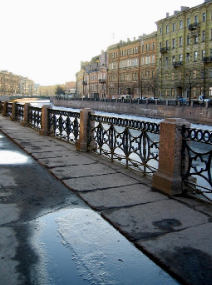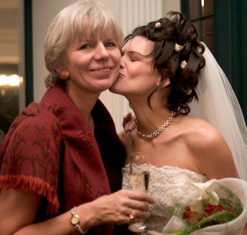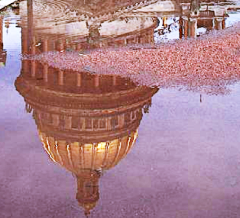St. Petersburg, Russia 1998
 Springtime had finally come to St. Petersburg. Walking along a canal, I realized that the “ice-arteries” were thawing in the city’s gloomy, glorious heart. I picked a path through the puddles and was hurrying along when a bright flash stopped me in my tracks. A gilded cathedral dome gleamed from a brown pool at my feet. The image was overarched by a vivid rainbow set in blue sky. It both took my breath away and drew me in like a magnet. Looking up from what was now my reflection, I realized that other masterpieces lined the path ahead — it was a mud puddle gallery.
Springtime had finally come to St. Petersburg. Walking along a canal, I realized that the “ice-arteries” were thawing in the city’s gloomy, glorious heart. I picked a path through the puddles and was hurrying along when a bright flash stopped me in my tracks. A gilded cathedral dome gleamed from a brown pool at my feet. The image was overarched by a vivid rainbow set in blue sky. It both took my breath away and drew me in like a magnet. Looking up from what was now my reflection, I realized that other masterpieces lined the path ahead — it was a mud puddle gallery.
That scene above took place during the start of my 13 years of developing young adults in Russia, but recurred often with the rains or thaws. Over time, I adopted the “mud puddle” as my absolute favorite metaphor for human development. But to connect you with why I find mud puddles so valuable, let me go back to the time of that first and most memorable 1998 encounter.
Lend Me Your Mirror?
That spring I was receiving intensive personal and professional help from one of my life’s most effective developers – a professor of psychology at St. Petersburg State University, Anke, who was also a master mentor. Having taken time to build rapport and gain my trust, she’d quickly discerned that, while aspiring, capable and confident, I had many unhelpful blindspots and few emotional skills.
A little background: My parents grew up in a time of “waste not, want not” as children who were to be “seen and not heard,” which they largely applied to how they raised their children. As products of the uncertain times of World War II and the Great Depression, survival had been the concern of everyday life, certainly not their feelings about life. Members of the Silent Generation, they worked sacrificially to provide for and to teach us stern traditional values — respect, fairness, gratitude, discipline, willpower and “cleanliness is next to godliness.” These mattered. But when it came to feelings, the model was “mind over matter.”
Fortunately, Anke could see the destitution in my emotional intelligence more than I could. Discerning my foremost need, she zeroed in on cultivating my Emotional Self-Awareness. Seemingly able to see what lay beyond words, she helped me build concepts, vocabulary and perspective through reflection — from every angle imaginable. She could strike that nimble balance between deep care and direct challenge and was a ninja question-asker:
 What’s happening? What are you feeling? What’s underneath that? What do you want? Who can help you? What are you afraid of? How do you know this is a fact? What happened when you ____? How open are you, really? What is stopping you: can’t, don’t want to, or won’t? What is your role, if any, in this? What is next? When will you do that? What are these tears saying to you and to me?
What’s happening? What are you feeling? What’s underneath that? What do you want? Who can help you? What are you afraid of? How do you know this is a fact? What happened when you ____? How open are you, really? What is stopping you: can’t, don’t want to, or won’t? What is your role, if any, in this? What is next? When will you do that? What are these tears saying to you and to me?
She would ask, listen, and again, ask, at times repeating the same question. While operating from a place of ease, it was far from easy for me to step up and face the Picasso-esque areas of my self-image. Was it mad? Sad? Glad? Egad, I couldn’t say. I was as alienated from my muddled emotions as I was quick to speak my emphatic mind.
When I wanted to crawl under a rock and hide, Anke urged me to “walk in the light” (i.e. learn to clearly communicate my needs and feelings). She spoke emotion words to me in a deliberate and intentional way. And importantly, Anke taught me to value swift and specific feedback as a gift, and life-giving correction as love! It was all very messy, but I can’t imagine marriage, other relationships or work, without her coaching.
Reflection Builds Connection: Neurons
I didn’t know it then, but in “lending me her mirror,” Anke was bulking up the volume and connectivity of areas of my brain’s “mirror neurons.” Mirror neurons are the only brain cells we know of that seem specialized to code the actions of other people, and also, our own actions. This network also gives us the ability to learn from other people’s triumphs and mistakes without having to experience them firsthand. Without this sensory input, we remain largely blind to the actions, intentions and emotions of other people.
Neuroscientist V. S. Ramachandran hypothesized that mirror neurons could be the basis of introspection, self-awareness and other awareness needed to create the mature representation of self. According to the Italian neurophysiologist, Rizzolatti, “The real-time understanding of the emotions of others, rendered possible by the emotional mirror neuron system, is a necessary condition for empathy…” These experts are saying that human relating is made possible through mirror neurons — the system that enables us to understand ourselves and our fellow humans. And understanding is a first step to mature and effective human interaction.
“It takes more than one human brain to create a human mind.”
— Lisa Eckman Barrett, How Emotions Are Made
Growth as the Goal?
Anke’s unruffled and inviting presence had been just what I needed. With time and practice, my self-protection lessened and self-perception grew more granular, which in turn, enabled me to better relate to others. Ironically, it went hand-in-hand with my Russian language acquisition. Deeply grateful and growing, I wanted to help others in the way I’d been helped. The campus where I worked was brimming with young adults who lacked well-developed awareness, or beyond that, carried soul-wounds from abuse, abandonment or alcoholic parents. I longed to help them find whole-heartedness, and yet I was no professor in psychology. I had studied engineering and spent my career integrating processes. How could I bring valuable help to others’ development?
That question became my quest as I set to work investing my life in university students in St. Petersburg. Much to my dismay, not all were up for the pains: the inevitable time, dedication and discomfort associated with growth. I’d get ruffled when they wanted to cling to old unhealthy patterns, and find myself unintentionally pushing, prodding, proving or possessing outcomes. When there was a halt or set back in someone’s progress, I supposed I was unproductive and powerless. I wasn’t “meeting my deliverable” in terms of my corporate-world construct. Was my growth-as-the-goal approach flawed?
The Value of Puddles
Through trial and (much) error, I realized that growth was not within my power to give and that I must disassociate “valuable” from “productive.” I could be hopeful, offer awareness in deliberate and intentional ways, and patiently bear with people… but I could not produce growth.
power to give and that I must disassociate “valuable” from “productive.” I could be hopeful, offer awareness in deliberate and intentional ways, and patiently bear with people… but I could not produce growth.
Enter again the mud puddle. What does a simple mixture of water and dust have to offer? Answer: the best conditions for fruitful coaching. I was finally beginning to see its value and helpfulness. Mud puddles bear images but are not overbearing. Unfettered by agendas or expectations, they give:
- A calm and unobtrusive space in which to reflect
- Boundaries to help narrow the search
- Perspective to those on the edge or stuck in the mud
- Opportunities for assessing without oppressing
- New points of view to explore and discover
- An invitation to “hop in” and get messy (c’mon!)
- A chance to strengthen the immune system
- Hopefulness, in the wake of bad weather
In a word, reflection. Mud puddles give a chance to see and understand life in a transformative way. In the same way, an effective coach, when free from the distortions of agitation, impatience or judgment, can serve someone’s journey with these gifts. This is one of the reasons I’m a fan of national mud puddle day!
It’s Only Human
There is a lot that goes into the making of a human, but two of our biggest ingredients are water and dirt (“humus” in Latin). And while it may seem humbling, we are all in a sense “mud puddles” by design. In and of themselves, we were built to bear beauty and offer value. So why not be on the lookout for your own puddle; maybe take your “inner child” by the hand and hop in… and then become a mud puddle mentor to others?
